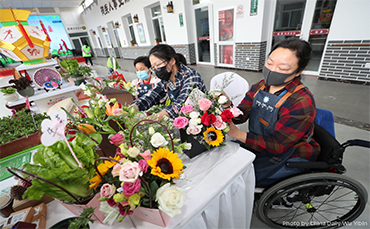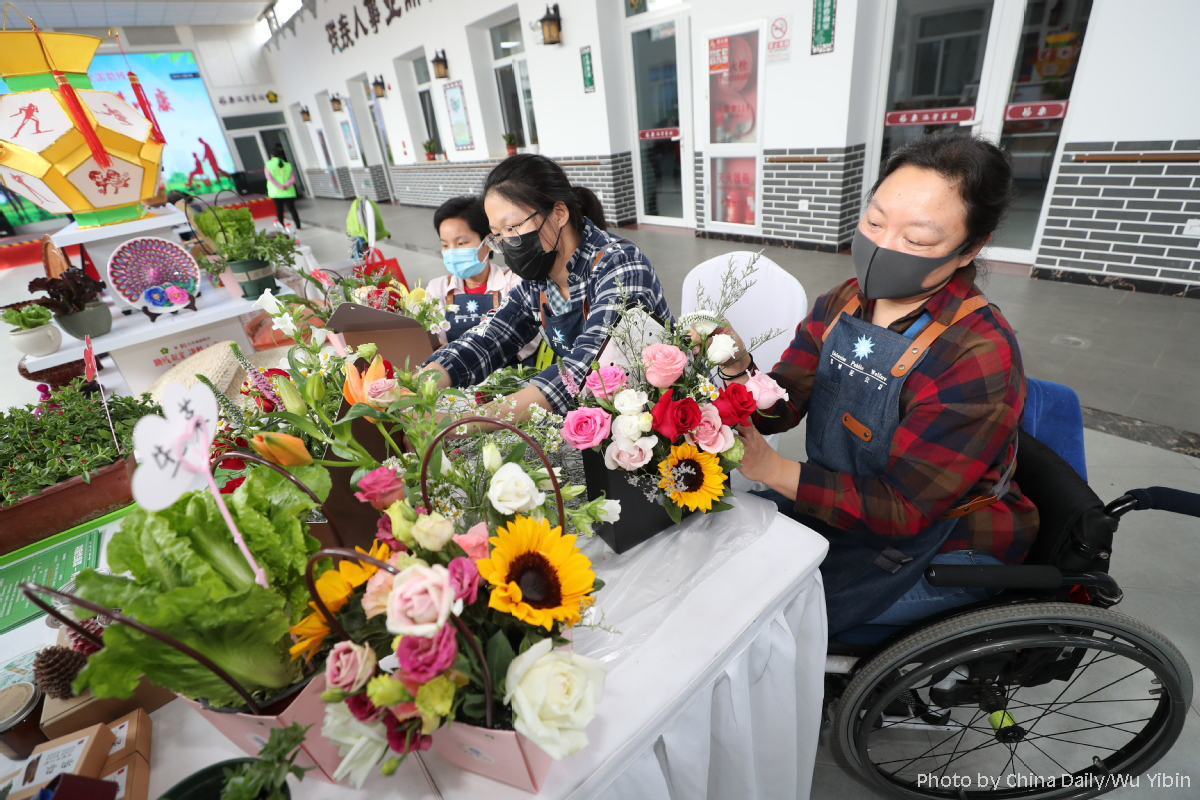



Disabled people take part in a flower arrangement training class at a center for the disabled in Beijing's Tongzhou district. [Photo by Wu Yibin from China Daily]
2. KEY MEASURES
Encourage the blind massage employment promotion activity. Support the construction of medical, rehabilitation, training, and other infrastructure for blind massage hospitals at the provincial level to form regional demonstration centers to drive the development of blind massage hospitals in the surrounding areas. Advocate blind medical massage workers to start their massage clinics. Speed up the establishment of standards for blind massage and improve the overall service. Give full play to the role of the blind massage training bases at all levels to standardize the blind massage training and further education. Develop new forms of employment for the blind via broadening channels.
Improve the employment service for persons with disabilities. Carry out the “Four Once” program of employment services for the disabled, that is, check the basic information of unemployed persons with disabilities at least one time in the eligible employment group, organize at least one time of vocational ability assessment for those eligible persons with employment needs, register their employment needs and provide relevant employment services at least once. Public employment service agencies at all levels should include the employment service for the disabled in their service range. Employment service agencies at or above the county level need to improve the standards and establish relevant rules and regulations. Regularly hold exchange activities on employment services for the disabled. Implement the requirements of the Protection and Development Plan for the People with Disabilities During the 14th Five-Year Plan Period on establishing a system of employment counselors for the disabled and promote the formation of the employment service workforce for them. Support some social service and human resource service agencies for the employment of disabled people, and include the employment service into the range of government purchased services.
Launch vocational skills improvement actions for the disabled. Based on the vocational ability assessment results of the disabled, led by the labor market demands, encourage the employers to engage in the construction of a training system, encourage the vocational colleges to actively develop employment and entrepreneurship training programs for people with disabilities by specific classifications. Introduce employment skills training, position skills improvement training, or start-up business training to the disabled persons with the employment needs and qualifications, and provide subsidies for training fees and living expenses (including traffic costs) to the qualified disabled persons. Strengthen the construction of vocational training bases for the disabled at all levels. Organize vocational skills competitions and vocational skills exchanges regularly. Expand the enrollment of disabled students in the middle and high vocational colleges, help young and strong disabled people with willing who have junior and senior high school education backgrounds to receive middle and high vocational education, and enjoy student funding policies.
3. PROTECTION AND SUPPORT
Institutional safeguards and support. The disabled working committees of people’s governments at all levels should strengthen the organization and coordination to urge relevant agencies and institutions to do better work in terms of the employment of people with disabilities. The employment boosting mechanism of governments at all levels should promote the implementation of policies related to employment for disabled workers. Each agency in charge of different actions shall, according to their specialties, guide localities to deliver their responsibilities. Disabled persons’ federation at all levels needs to cooperate with relevant agencies to improve, implement, and publicize policies to support the employment and entrepreneurship of disabled people, accurately grasp and share information on their employment status and needs of them, and organize and launch the employment assistance activities, and carry out employment services and vocational skills training.
Policy support. Implement the Employment Measures for Governmental Agencies, Public Institutions, and State-owned Enterprises to Take the Lead in Arranging the Disabled Persons issued by the Organization Department of the Central Commission, China’s Disabled Persons’ Federation, and all the relevant departments and institutions. Provide convenience for persons with disabilities to participate in recruitment examinations, and rationally define the physical conditions of employment for the disabled workers. Encourage innovative models of proportional employment for disabled workers. Provide employment subsidies for eligible disabled people in employment and entrepreneurship according to the regulations. Implement relevant regulations on government procurement, and carry out various types of employment services and vocational training for the disabled. Formulate management specifications of employment services and vocational training services for persons with disabilities. Establish the collaboration and paired assistance mechanism between the eastern and western regions for disabled people. And include the qualified employees with work-related injuries and disabilities in the employment service system for the disabled.
Funding protection. All localities should implement the Protection and Development Plan for the People with Disabilities During the 14th Five-Year Plan Period, as well as the General Plan on Improving the Employment Security Fund System to Promote the Employment for People with Disabilities issued by the National Development and Reform Commission and relevant departments as well, to ensure the funding in terms of employment training, employment service, and subsidies and incentives for the disabled to find jobs and start businesses. It is necessary to formulate implementation measures for key projects of employment subsidies and incentives for disabled persons and specify the standards and conditions of subsidies and incentives. Coordinate and make good use of all kinds of funding for employment and entrepreneurship for people with disabilities to avoid misuse. Provide support for various types of employment assistance and the construction of training bases under the regulations. Increase the reward for employers who recruit disabled workers exceeding the specified proportion.
Information support. Based on the national integrated government services system and government service institutions at all levels to realize the interconnection of employment data for disabled workers. Provide more government services in terms of the employment status of disabled persons on a cross-provincial basis all over the country to implement the protection and support. Relying on the national employment and entrepreneurship network service platform for people with disabilities, establish a national vocational training service and management system for the disabled that includes information on various types of vocational skills training institutions, training project announcement and certificate management, training evaluation, online training resources, and so on. And issue a national list of human resources service institutions as well as a catalog with a focus on employment and entrepreneurship service for the disabled.
Publicity and mobilization. Launch the activity of “2022 Employment Publicity for Persons with Disabilities”. Make full use of important timings such as the employment assistance month, China's National Disability Day, International Day of Persons with Disabilities, etc. to increase the publicity on the employment of disabled persons. Adopt easy-to-understand and simple words, pictures and videos to disseminate employment and entrepreneurship support policies for disabled people, employers’ social responsibilities for arranging disabled workers, employment capability and potential of disabled people via broadcast and television, newspapers, the Internet, and new media platforms, and promote the employment service process, feedback channels and information access for them. According to the national regulations, publicize the information of institutions and individuals who have made an outstanding contribution to the employment of disabled persons.
Supervision and implementation. Local governments at all levels should further designate the departments in charge of relevant actions with clearly defined responsibilities to ensure the implementation of the measures. It is necessary to protect the employment rights and interests of disabled persons under the law, firmly prevent and crack down on activities such as false arrangements for the employment of people with disabilities and encroaching on their employment rights, and supervise and assess the implementation of the employment program annually to discover and solve the issues during the implementation process. Every Provincial Disabled Persons’ Working Committee should report the employment program implementation results to the State Council Disabled Persons’ Working Committee at the end of each year and organize at least one assessment of the implementation result and effectiveness of policies to support the employment and entrepreneurship of disabled people during the implementation process. By the end of 2024, relying on the national employment and vocational training information management system for people with disabilities, the Office of the State Council Disabled Persons’ Working Committee, together with relevant departments and institutions, will conduct a summary assessment of the implementation results of this program.
Source:
<http://www.gov.cn/zhengce/content/2022-04/08/content_5684090.htm>
<http://english.www.gov.cn/policies/latestreleases/202204/08/content_WS624ffebfc6d02e5335328eee.html>
Edited and translated by Guo Xinxin